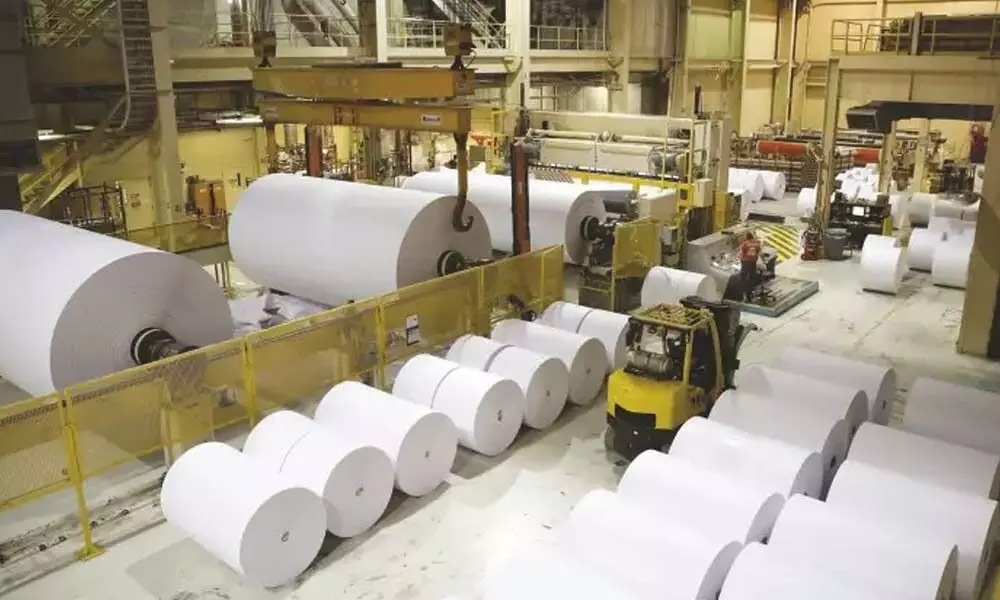Paper industry pins hopes on policy initiatives for agroforestry
The Indian paper industry, which is passing through challenging phase and is hard-pressed for raw materials in view of supply-side constraints, is pinning high hopes on policy initiatives for agroforestry and some other sops for the industry.
image for illustrative purpose

The Indian paper industry, which is passing through challenging phase and is hard-pressed for raw materials in view of supply-side constraints, is pinning high hopes on policy initiatives for agroforestry and some other sops for the industry. This is notwithstanding the fact that the Union Finance Ministry and Union Agriculture ministry have recently initiated some positive moves for the industry. Mind you that the Indian paper industry accounts for about five per cent of the world's production of paper. The estimated turnover of the Indian paper industry is Rs 70,000 crore and its contribution to the exchequer is around Rs5,000 crore. The industry provides direct employment to 500,000 persons, and indirectly to around 1.5 million. Paper mills use a variety of raw materials viz. wood, bamboo, recycled fibre, bagasse, wheat straw, rice husk, etc. In terms of share in total production, approximately 21 per cent are based on wood, 71 per cent on recycled fibre and 8 per cent on agro-residues. The per capita paper consumption in India at around 15 kg, is way behind the global average of 57 kg.
Union Finance Minister Nirmala Sitharaman, in her last budget speech said that policies and required legislative changes to promote agroforestry and private forestry will be brought in soon. Subsequently, the Ministry of Agriculture has also stated that financial support will be provided to the farmers to promote agroforestry. These gestures have gone down well in paper industry circles.
However, if one goes by what AS Mehta, president, Indian Paper Manufacturers Association (IPMA), says that despite the efforts of the paper industry in promoting plantations against all odds, the availability of wood domestically is still inadequate compared to the demand of India's paper industry. According to the Indian Paper Manufacturers Association (IPMA), the availability of additional 25 lakh hectares of land for agroforestry, besides the industry's own agroforestry drive, will go a long way in ensuring raw material security for all wood-based industries.
If additional 25 lakh hectares of degraded land (forest land, non-forest Government land, Forest Development Corporation Land, etc.) in the country is harnessed for the agroforestry programme, it can provide employment to at least 10-15 lakh persons, supplement incomes of farmers, increase country's tree cover, provide environmental benefit, and also generate enough raw material for all wood-based industries at globally competitive rates. This is also necessary to make India's paper manufacturers competitive vis-à-vis ASEAN players who have long-term forest concessions in their countries and can export paper to India at nil basic customs duty under the Free Trade Agreement between India and ASEAN.
There are, however, some sore points. The paper industry has stated that an increase in the basic customs duty on import of recovered paper/wastepaper, an important raw material used by the Paper Industry, from nil to 2.5 per cent has come as a dampener. An increase in import duty on wastepaper will add to the production cost. Since the domestic paper recovery rate in India is around only 40 per cent as compared to over 70 per cent in developed countries, the import of recovered paper/wastepaper is crucial for domestic value addition to meet the growing demand for paper in the country, and also for exports. Imposition of import duty on recovered paper/wastepaper will harm the competitiveness of India's paper industry and is not justified till the time that the collection and recovery of waste paper in the country does not increase significantly through efforts by all stakeholders towards domestic waste segregation and recycling.
Policy makers must keep in mind that India is the fastest-growing market for paper globally and it presents an exciting scenario. Paper consumption is poised for a big leap forward in sync with economic growth. The futuristic view is that growth in paper consumption would be in multiples of GDP and hence an increase in consumption by one kg per capita would lead to an increase in demand of 1 million tonne.

